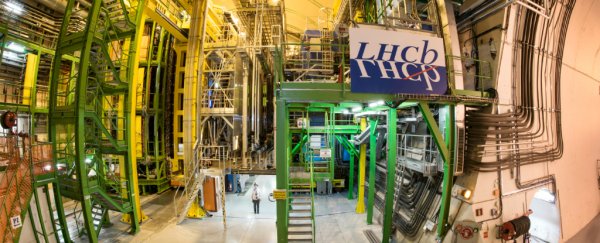Scientists at the Large Hadron Collider (LHC) have just announced tantalising new data that hint at deviations or flaws in the Standard Model of physics.
The researchers have found evidence that subatomic particles called B mesons don't fall apart the way our current understanding of physics predicts. This could be the effect of a new particle or phenomenon currently unknown to science.
"Deviations such as what we see now are very exciting in the sense that if there are new particles, it means we can eventually use those new building blocks," CERN physicist Freya Blekman, also a professor at the Vrije Universiteit Brussel, told Abigal Beall from Wired.
To be clear, this inconsistency has so far only been measured with a certainty of 2.2 to 2.5 sigma - which means there's up to roughly a 1 in 100 chance that it's the result of random chance and isn't really evidence of new physics.
In order for the physics world to take the result seriously, the researchers need to reach at least a 3 sigma confidence level (99.87 percent confidence in the result), and for that they simply need more data - something they'll get plenty of when the LHC switches on again next month for its summer run.
For now, though, researchers are definitely paying attention.
"[T]he result is intriguing because a recent measurement by LHCb involving a related decay exhibited similar behaviour," CERN explains in a press release.
So what does all of this mean?
One of the LHC's main goals is to find evidence of physics beyond the Standard Model of particle physics - the best set of equations we currently have to explain how the Universe and everything in it works.
To date, the Standard Model has served us well, but there are a lot of things it can't explain - such as gravity, and the weird effects of dark matter and energy.
Importantly, it's been impossible to use the Standard Model to bridge the seemingly disparate worlds of quantum physics and general relativity - something physicists really need to do if they want to get a full comprehension of how the world works.
So scientists assume that either our current understanding of the Standard Model is wrong, or there are important physics beyond the Standard Model that lie just out of our grasp.
And the best way to find that out is to use the LHC to smash particles together over and over again at hugely high energies and observe the fallout and subsequent decay of subatomic particles.
Most of the time, this decay matches up with what we predict with the Standard Model. But sometimes, something else happens, which was the first sign CERN scientists saw back in 2012 that they'd finally found the Higgs Boson.
And now we've got more early evidence that something strange is going on.
The data in question comes from the LHC beauty or LHCb experiment.
This experiment was smashing together particles and looking at the decay of specific subatomic particles called B mesons.
When B mesons decay, they become an excited kaon and a pair of leptons - either electrons or muons.
Muons are 200 times heavier than electrons, but according to the Standard Model, their interactions should otherwise be identical to those of the electron, which is a property known as lepton universality.
Lepton universality predicts that generally electrons and muons should be produced with the same probability in B meson decay the LHCb had measured. That means the researchers sifting through the data were looking for an electron/muon ratio of 1 or close to 1.
But that's not what they found.
Instead, the ratio was closer to 0.7, with electrons more likely to be produced than muons.
The researchers presented their initial findings at a conference at CERN this week, but again, made it very clear that it's too soon to say for sure whether they've found anything of note.
"For particle physicists, this result is tantalising but not evidence for anything," Blekman told Wired.
"More data and more observations of similar decays are needed in order to clarify whether these hints are just a statistical fluctuation or the first signs for new particles that would extend and complete the Standard Model of particle physics," CERN added in a press release.
So far, the researchers have only looked at data from the LHC's first run - which lasted from 2008 to 2013.
Going through data collected during the collider's second run, which lasts from 2015 to 2018 - as well as performing new experiments on B meson decay - will be crucial to revealing whether we're on the verge of finding new physics.
If it's confirmed that there's something behind these early hints, it would be a pretty big deal for physicists.
"Either lepton universality is not true, or there is something extra happening, for example, a new extra intermediate particle," Blekman told Wired.
"Proving and explaining, either way, would be amazing and would completely change the way we understand how matter sticks together … particularly if there are new particles, new forces that can explain things like dark matter in the galaxy or how the Universe formed."
We'll be following the progress closely, so watch this space.
